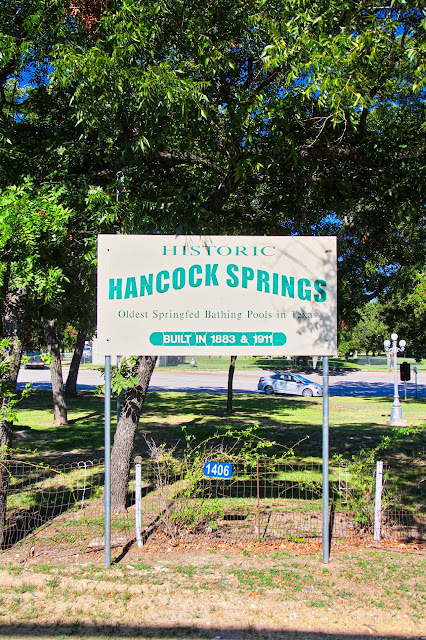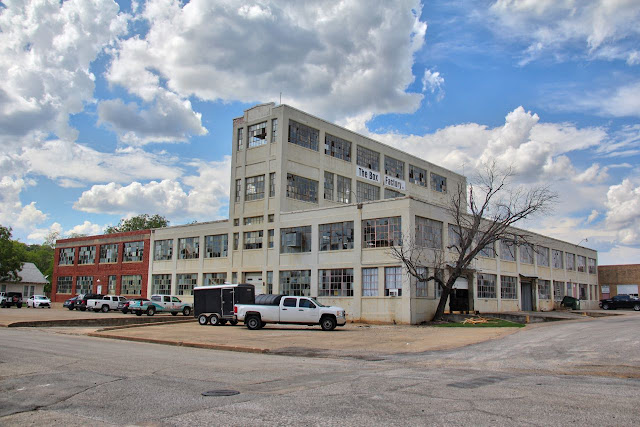I have a photo blog
over here focused on the world of watery post cards, especially artesian wells (and especially artesian wells in Texas). Along those lines, I took a few days off work to tour north Texas to find the location of the Jumbo artesian well in Fort Worth drilled in 1891. Along the way, I stopped in Lampasas, Glen Rose, and Mineral Wells. I also stopped in Dallas on the way home to see about getting a high-res photo of the Dallas Jumbo drilled right after Fort Worth drilled their well.
Back in the 1880s thru 1910s, Texas, like many places across the United States, went into an artesian-well drilling frenzy, which reached a fever pitch in the 1890s. The water wasn't always artesian, it wasn't always fresh, and it wasn't always water (many of Texas' early oil fields were discovered while drilling for water), but folks tended to find a use for whatever they found. In Lampasas, Glen Rose, Mineral Wells, and many other locations, the water came up laced with minerals purported to cure some ailments (generally, this water helped to [ahem] grease your digestive track...).
Waco, followed by Fort Worth and Dallas, tapped into the nether regions of the Trinity Aquifer to find million-gallon-a-day free-flowing wells of fresh water. Unfortunately, folks, misled by pseudo-scientists who claimed an infinite amount of water, left their wells constantly flowing as status symbols, quickly bleeding off the free-flowing pressure until the aquifers flowed no more by 1910.
lampasas
The bride makes fun of me for taking her to dried-up springs, so it's ironic that when I go on a solo trip, I get to see still-flowing springs. Lampasas was quite lovely and will be worth a return trip with the bride.
As you approach Hancock Springs, you can smell the sulfur. And the springs are still an operational swimming hole!
Hancock Springs back in the day:
Lampasas County courthouse:
The blue line on the side of this building (with the stork) marks the height of the epic drought-busting flood in the 1950s:
For some reason, the historical marker for Hanna Springs is on the courthouse square and not at the springs about a mile away:
Hanna Spring:
Hanna Springs back in the day:
It took a little hunting to find the Abney Plunge:
Is this the old Abney well?
Lots of murals about Lampasas:
glen rose
Before Glen Rose was known for dinosaur tracks, it was known as a resort to partake of its mineral wells.
The courthouse:
This fountain is supposed to be fed by an artesian mineral well (drinking fountain spigots weren't working):
The Snyder Sanitarium where patrons could (and still can!) partake of mineral waters:
The Oakdale Plunge, almost 100 years old and originally fed by a mineral well, is still going strong:
Oakdale Plunge back in the day:
mineral wells
I did some environmental work at Fort Wolters back in the 1990s, and I vividly remember first driving into Mineral Wells and being shocked at the size of what-I-learned-later-was the Baker Hotel. Mineral Wells was a big deal back in the day. Its architectural history resembles Vegas in the way it renewed itself and its buildings over and over as it grew more popular.
Remnants of the Rock Castle south of town:
The Rock Castle back in the day:
Amazingly, there is still an operational water bar in town at the old Dismuke's Famous Mineral Water locale:
Look carefully: The grout spells "FAMOUS":
Famous now houses the reincarnation of Crazy Water, the most (ahem) famous of the mineral waters from Mineral Wells (available at Whole Foods). The site has three wells tapped into three different formations pulling varying levels of saline groundwater.
Dismukes back in the day:
The new Crazy is thankfully doing quite well. They have also taken over the old Crazy Crystals factory as a staging area to package and ship their water:
The Crazy Crystals factory back in the day:
Crazy Crystals was desiccated Crazy Water that you could mix with water at your locale to recreate Mineral Wells water.
Cool bench outside a church:
There's a deep canal that runs through the heart of town that used to drain mineral water waste:
Sadly, not many of the original buildings have survived, victims of fires or renewal. I was able to locate the Norwood, which used to have a direct pipeline connection to Dismuke's water down the street:
The Norwood back in the day:
The old hospital:
The hospital back in the day:
The Crazy Hotel was one of the two most famous hotels in town during the town's glory years. When I first visited back in the 1990s, it was a retirement home; it's now abandoned:
Evolution of the Crazy:
Near the Crazy:
The Baker Hotel is something else. Built in the 1930s (and opening just as the Great Depression started), it is a massive landmark in town. Mineral Wells hopes to restore this gem. I hope they do!
The Baker in post cards:
Allow me a moment to explain what water from Mineral Wells does to you:
fort worth
Most of Fort Worth's artesian well history has been destroyed, but I stopped in to see if I could find the location of their Jumbo well and find anything at their history center. After deducing one of the cross streets and assuming that they drilled at the top of the hill I unknowingly parked 20 feet away from the well site. I stopped in to a nearby business to see if they knew of a well, and they had an old plat that showed the exact location!
The well was in the foreground as the pavement transitions to grass:
dallas
Finally, I made my way over to Dallas to visit Old Red, the old courthouse, and Dallas' Jumbo well, which still exists:
Big Red back in the day:
If you look closely in the lower right corners of the images above, you can barely pick out the derrick for the well.




























































































































